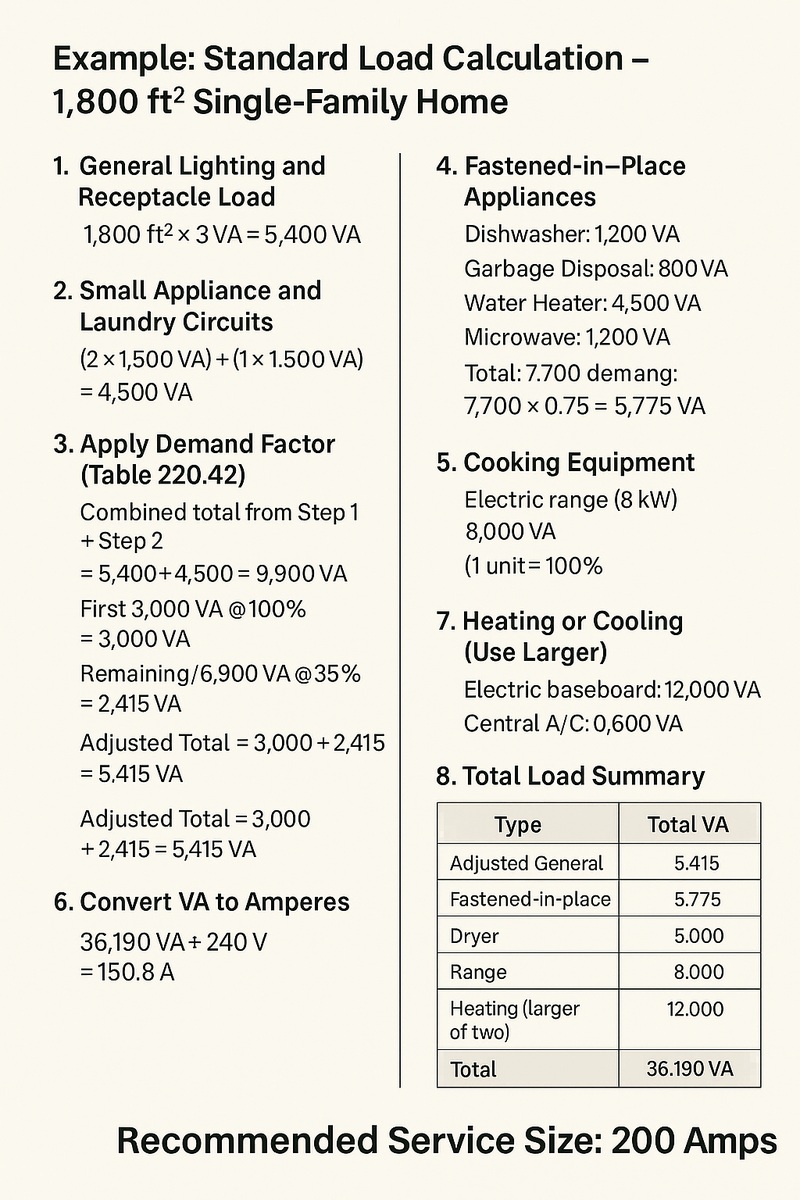
Accurate load calculation is essential for sizing the electrical service of a residential dwelling. The Standard Method, outlined in NEC 2023, Article 220 Part III, provides a structured approach to determining the minimum service size based on connected loads and demand factors.
Here’s a step-by-step breakdown of how to perform the load calculation for a single-family home using the Standard Method.
Step 1: General Lighting and Receptacle Loads
Per NEC 220.12(A):
-
Use 3 VA per square foot of habitable space
-
Exclude open porches, garages, and unfinished basements
Example:
For a 1,800 ft² home:
1,800ft²×3VA=5,400VA
Step 2: Small Appliance and Laundry Circuit Loads
Per NEC 220.52:
-
Two small appliance circuits = 1,500 VA × 2 = 3,000 VA
-
One laundry circuit = 1,500 VA
Total = 4,500 VA
Step 3: Apply Demand Factors (Table 220.42)
Apply the following to the sum of general lighting and circuit loads:
| Load Range | Demand Factor |
|---|---|
| First 3,000 VA | 100% |
| Next 117,000 VA | 35% |
| Above 120,000 VA | 25% |
This adjustment accounts for typical residential diversity.
Step 4: Fastened-in-Place Appliances
Per NEC 220.53, include:
-
Dishwasher, garbage disposal, water heater, etc.
-
Use nameplate VA ratings
If 4 or more appliances are included (excluding HVAC), apply a 75% demand factor.
Step 5: Clothes Dryer
Per NEC 220.54:
-
Use 5,000 VA or nameplate rating (whichever is larger)
-
One dryer = 100% demand
Step 6: Cooking Equipment
Per NEC 220.55:
-
Use nameplate rating
-
Apply demand factor from Table 220.55 depending on quantity and size of ranges
Step 7: Heating or Air Conditioning
Per NEC 220.60, include only the larger of:
-
The total heating load (e.g., electric baseboard, furnace)
-
Or the total cooling load (e.g., air conditioning, heat pump)
Do not include both in the calculation.
Step 8: Total Load and Service Size
Add all adjusted loads together to determine total connected VA. Then, calculate:
Total Load (VA)÷240V=Amps Required
Round up to the next standard breaker size.
Conclusion
The Standard Method ensures safe, code-compliant service sizing tailored to real-world residential use. While more detailed than the Optional Method (NEC 220.82), it provides flexibility in load combinations and ensures proper demand factoring.
Always reference the latest NEC edition and coordinate with your local AHJ (Authority Having Jurisdiction).
Refer to the link below to begin the Optional Method load calculation for single dwelling unit:

